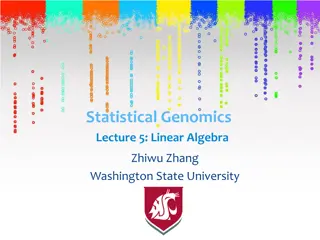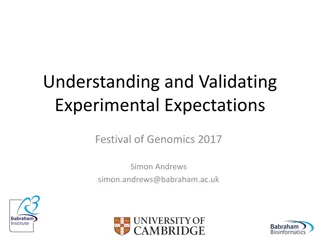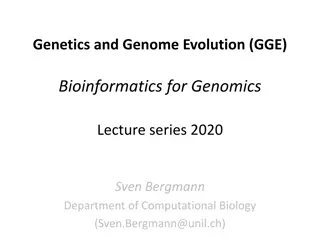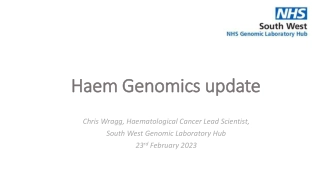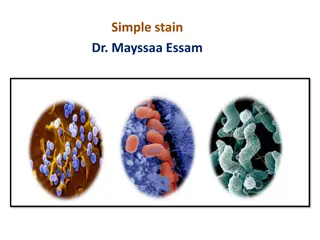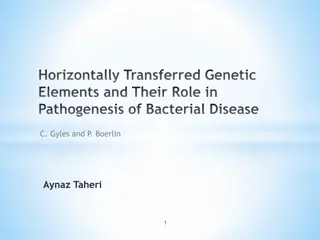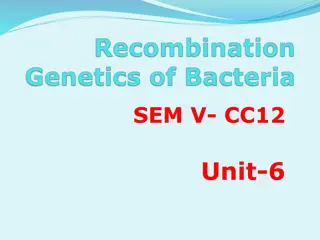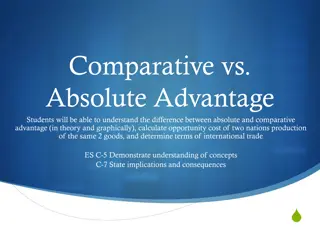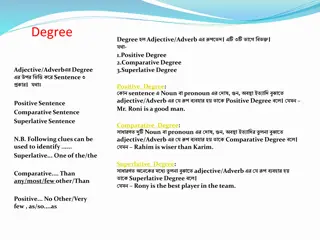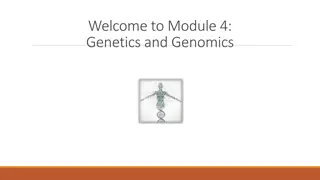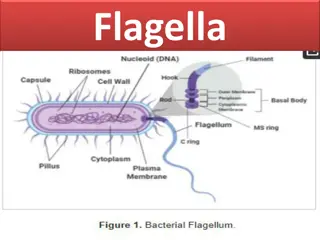Understanding Bacterial Comparative Genomics: A Comprehensive Overview
Delve into the realm of bacterial comparative genomics with insights on terminologies, assembly methods, annotation processes, and two key approaches to microbial genomics. Explore the basics of genomics terminology, assembly-based and variant-based analyses, as well as annotation methods for protein-coding genes, all presented with clarity and relevance.
Download Presentation

Please find below an Image/Link to download the presentation.
The content on the website is provided AS IS for your information and personal use only. It may not be sold, licensed, or shared on other websites without obtaining consent from the author. Download presentation by click this link. If you encounter any issues during the download, it is possible that the publisher has removed the file from their server.
E N D
Presentation Transcript
Bacterial Comparative Genomics Christopher Desjardins, Ph.D. Earl Lab Broad Institute
Outline Genomics Terminology Assemblies vs. Variants Assembly-based analyses Orthology Variant-based analyses How to choose?
Basic Genomics Terminology Assembly: Reconstruction of a longer sequence from smaller sequencing reads Annotation: Assigning a function to a string of nucleotides Variant calling: Identifying differences between a set of sequencing reads and a reference assembly
Two Approaches to Microbial Genomics Starting with sets of reads representing your study isolates A B C D Assembly-based 1. Assemble each set of reads into a genome sequence 2. Annotate each genome 3. Cluster genes and compare between each genome Variant-based 1. Compare each read set to a reference genome assembly 2. Directly compare variants between each genome
Assembly-Based Approach 1. Assemble each genome (de novo or reference- based) A B C D
Assembly Basics Genomic DNA AGCTGTAAGC AGCAACGCTTGTAAATGTAGCTTAG contig contig supercontig (scaffold)
Assembly Methods SPAdes (http://cab.spbu.ru/software/spades/) Velvet (https://www.ebi.ac.uk/~zerbino/velvet/) Both are De Bruijn graph assemblers K-mers Edwards and Holt 2013 MIE
Assembly-Based Approach 2. Annotate each genome A B C D
Annotation Methods Annotation refers to assign function to DNA sequences There are different annotation algorithms for protein- coding genes, tRNAs, rRNAs, other non-coding RNAs Prokka (http://www.vicbioinformatics.com/software.prokka.sht ml) is an all-in-one wrapper for these tools
Annotation of Protein-Coding Genes Prodigal (http://prodigal.ornl.gov/) 1. Identify high confidence genes (long ORFs +) ORF = open reading frame 2. Identify features of those genes 3. Find other areas on genome with shared features 4. Refine predictions
Assembly-Based Approach 2. Cluster genes A B C D 8 7 6 8 7 7 6 7 2 5 5 5 1 1 1 1 3 4 4 4 5 3 3 2 2 4 2 3
Orthology Orthologs are genes whose most recent divergence was a speciation event Paralogs are genes whose most recent divergence was a gene duplication event Groups of orthologous and paralogous genes are termed ortholog clusters or gene clusters or even just genes and form the basis of all gene-based comparative genomics
Gene Trees vs Species Trees Species Tree A B C
Gene Trees vs Species Trees Species Tree Gene Tree A1 and B1 are orthologs A1 and C1 are orthologs B1 and C1 are orthologs A1 B1 C1
Gene Trees vs Species Trees Species Tree Gene Tree B1 and B2 are paralogs A1 and B1 are orthologs A1 and B2 are orthologs All of these genes would form a single gene cluster B2 A1 B1 C1
Gene Names, Orthology, and Function When you ask, does strain A have gene X?... What you are really asking is, does strain A have an ortholog of gene X? (where gene X is characterized in another strain) If two genes are orthologs, that does not imply they have same function, but they often do If two genes are paralogs, they have traditionally thought to often differ in function, and paralogy is thought to be one of the main sources of new genes but there is some evidence to suggest that paralogs are often more similar in function
Gene Clustering - how it works Assess the similarity of every gene to every other gene e.g., using BLAST Use that similarity to join pairs of genes e.g., using Reciprocal Best Hits Connect the gene pairs into larger clusters e.g., using Reciprocal Best Hits or Markov clustering
Pairwise Clustering - Reciprocal Best Hits Reciprocal Best Hits (RBH) is a simple and popular clustering algorithm Two proteins X and Y from species A and B, respectively, are considered orthologs if protein X is the best BLAST hit for protein Y and protein Y is the best BLAST hit for protein X (i.e., they are reciprocal best hits) Genome A Genome B X Y
Clustering - Reciprocal Best Hits The logic of RBH can then be extended from pairs of genomes to three or more genomes i.e., Three proteins X, Y, and Z, respectively, from species A, B, and C, respectively, are considered orthologs if each protein is the best BLAST hit for each protein all genomes X Y Z Addition of paralogs is not part of the RBH algorithm, but can be done as post-processing step
Clustering - OrthoMCL OrthoMCL is an extremely popular gene clustering program OrthoMCL uses reciprocal best hits to identify orthologs between pairs of genomes Beyond genome pairs, it uses a Markov cluster algorithm (MCL) to assemble groups of orthologs and paralogs If that sounds black box, it s because it is! It does not scale well to hundreds of genomes, so as sequencing throughput continues to increase, OrthoMCL is losing popularity
Gene Content Profiles Orthologous gene clusters can then be used to build gene content profiles - binary coding of gene presence/absence across genomes These profiles can then be easily queried to identify genes unique to a given set of genomes easily identifies clade-specific genes can also look for perfect correlations of genes with phenotypes Species A Species B Species C Species D Cluster W 1 1 0 0 Cluster X 0 0 1 1 Cluster Y 1 1 1 0 Cluster Z 1 1 1 1
Gene Content Profiles Species A Species B Species C Species D Profile Type Cluster S 1 1 1 1 Single copy core Cluster T 1 2 2 1 Multi-copy core Cluster U 1 1 0 0 Auxillary Cluster V 2 0 0 0 Unique Cluster terminology: Core = orthologs are present in all genomes Auxillary = genes with orthologs in at least two genomes but not all genomes Unique = genes without orthologs Sum of all of these genes is called the pan genome Single-copy = genes without paralogs in any genome Multi-copy = genes with paralogs in at least one genome
Organismal Phylogenies Single-copy core genes are often used to create organismal phylogenies Genes can be aligned with MUSCLE or CLUSTAL Then sequences are concatenated, or attached together end-to-end, so that the end of gene A is followed by the beginning of gene B Then a phylogeny is generated using available software like RAxML or FastTree Beware horizontal transfer!
Other potential downstream analyses Look for rapidly evolving genes by calculating evolutionary rates Functional enrichment of genes specific to a clade Association tests of gene presence/absence with a specific phenotype
Two Approaches to Microbial Genomics Starting with sets of reads representing your study isolates A B C D Assembly-based 1. Assemble each set of reads into a genome sequence 2. Annotate each genome 3. Cluster genes and compare between each genome Variant-based 1. Compare each read set to a reference genome assembly 2. Directly compare variants between each genome
Variant-Based Approach 1. Align reads to a reference genome A B C D
Read Alignment Methods Goal: to find the best match or matches of a read to reference genome While it seems simple, it s actually a difficult problem since you cannot check all possibilities (need heuristics) Un-spliced aligners (DNA to DNA, cDNA to cDNA) BWA (http://bio-bwa.sourceforge.net/) Bowtie2 (http://bowtie- bio.sourceforge.net/bowtie2/index.shtml)
Variant-Based Approach 2. Call variants A B C D
Variants Single nucleotide polymorphisms (SNPs) Ref AGGTCGT Alt AGGCCGT Ref AGGT---CGT Alt AGGTCCCCGT Insertion Ref AGGTCGT Alt AGG-CGT Deletion Substitution Ref AGGTATGCGT Alt AGGCCC-CGT
Variant Calling Methods Variant calling process: decide which differences in an alignment to a reference represent real differences and not errors in alignment or sequencing Pilon (https://github.com/broadinstitute/pilon/wiki): Program for assembly improvement and also SNP calling Initially developed for haploid genomes but now also works on diploid genomes Uses internal heuristics for quality control GATK (https://software.broadinstitute.org/gatk/): Program for SNP calling only Initially developed for diploid genomes but has been adapted to other ploidies Requires truth set or hard filters for quality control
Pilon Walker, Abeel, et. al 2014 PLOS ONE
Variant-Based Approach 3. Compare variants directly A B C D
Downstream analyses of variants Annotation of variant effects Captures very different information than gene presence/absence: nonsynonymous and synonymous changes, frameshifts and introduced stop codons, promoter mutations SNP-based phylogenetic analysis SNP-based analysis of evolutionary rates Enrichment of variant types in specific sets of genes Association tests of variants with a specific phenotype (GWAS)
Genome-Wide Association Studies (GWAS) Basic anatomy of GWAS: Count alleles for each polymorphic site Evaluate allele with Chi- squared or Fisher s exact test Correct for multiple comparisons Countless more complex variations of GWAS exist Fundamentally the same idea as an enrichment test image from Wikipedia
2x2 Contingency Tests Phenotype A Phenotype B Genotype X 17 5 Genotype Y 3 23 Fisher s exact test follows the hypergeometric distribution an exact statistic, so, it becomes difficult to calculate for large numbers recommended use case: any cell < 5 Chi-Squared test follows the chi-squared distribution an approximate statistic, so, easy to calculate for large numbers recommended use case: all cells are > 5
Multiple Comparison Correction Basic concept: the more statistical tests you do, the more likely one is to be significant by chance Bonferroni multiply the p-value by the number of comparisons simple but very conservative False Discovery Rate (FDR) more complicated but less conservative
Manhattan Plots Statistical significance values are plotted on the Y axis, while genome position is plotted on the X axis -log normalizes values between 0-1 such that 10-fold decrease in p- value causes the normalized value to increase by 1 image from Wikipedia
Bacteria and GWAS Most GWAS methods depend on linkage disequilibrium being slowly broken up by meiotic recombination, such that alleles physically distant from each other are independent Many bacteria have limited or no recombination, making GWAS difficult Adapting GWAS to bacteria is an active area of research Figure from Weissglas-Volkov et al. Diabetes 2006
Pros and Cons of Approaches Assembly-based - Results are not directly comparable and must be clustered - Large number of steps increases chance of error (n + n + (n-1)!) + Captures unique regions in each strain + Works on both closely and distantly related strains Variant-based + Can compare variants directly without clustering + Small number of steps decreases chance of error (1 + 1 + n) - Only captures regions present in reference - Works only on closely related strains x
Deciding on an Approach Does my reference contain most of my genes of interest? Are my strains closely related to a reference (>=95% identity) If the answer to both questions is yes, the variant-based approach is favored If the answer to either question is no, the assembly-based approach is favored
The afternoon laboratory will walk through the variant-based approach Questions?



